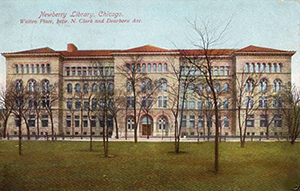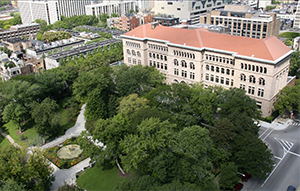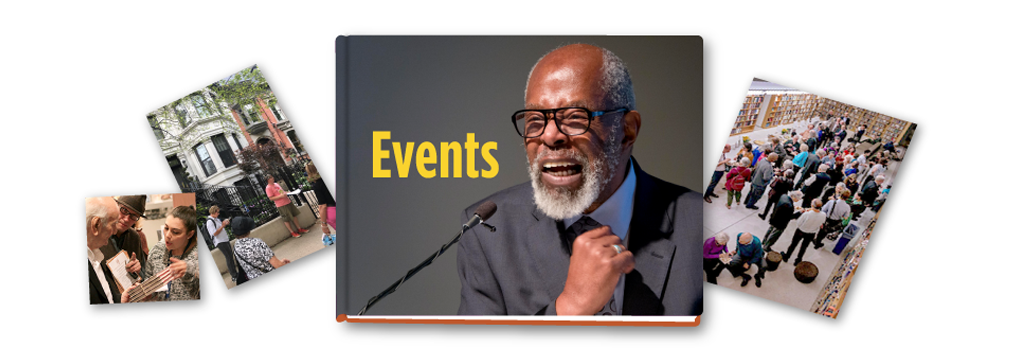Newberry Library
by Donald G. Evans

1909
When V.I. Warshawski finally wrangles control of a rare concerto in the short story “Grace Notes,” she entrusts Newberry Library’s music archivist Isabel Thompson with its indefinite preservation. On the dedication page of Breakdown, Paretsky credits past Newberry Library president Bill Towner as one of the librarians who helped her “navigate the great sea of learning.” And, of course, Paretsky arranged to house her first batch of papers in the Newberry holdings.
It is generally known that the Newberry Library ranks among the best research institutes in the world, but what is less well-known is that it relentlessly supports Chicago’s incredible literary heritage.
The Newberry figures in the lives of many Chicago writers, as well as their fictional creations. It is here that Henry DeTamble meets his future wife Clare Anne Abshire in Audrey Niffenegger’s bestselling novel The Time Traveler’s Wife. Clare, in her first-person narrative, says, “The library is cool and smells like carpet cleaner, although all I can see is marble.”
Niffenegger is another of the many prominent living authors whose papers are held by the Newberry. Chicago historical authors in the Newberry Library Collection include Nelson Algren, Sherwood Anderson, Fanny Butcher, Jack Conroy, Malcolm Cowley, Mitchell Dawson, Floyd Dell, Finley Peter Dunne, James T. Farrell, Henry Blake Fuller, Harry Hansen, Ben Hecht, Ernest Hemingway, Ring Lardner, D’Arcy McNickle, Arthur Meeker, William Morton Payne, and Eunice Tietjens. Algren (2010), Anderson (2012), Butcher (2016), Dell (2015), Farrell (2012), Fuller (2017), Hecht (2013), Hemingway (2012), and Lardner (2016) have all been inducted into the Chicago Literary Hall of Fame. That accounts for nine of our 45 inductees.
The Newberry Library, over the years, has also supported prominent writers, like Era Bell Thompson, through fellowships. Thompson, then a clerk and student at Northwestern University’s Medill School of Journalism, pitched her biography American Daughter to win the fellowship; she published the book in 1946 with the encouragement of Newberry librarian Stanley Pargellis. Thompson went on to have a successful literary career, publishing a second memoir and serving nearly four decades as an editor of Ebony, which hired her a year after her first book came out. Algren held a Newberry fellowship in 1948 during the time when he wrote The Man with the Golden Arm, winner of the first National Book Award in 1950 and the basis for a successful Hollywood film starring Frank Sinatra as Frankie Machine. Contemporary writers, like Tara Betts, have also been Newberry fellows.
The Newberry Library is now more than 125 years old, recently updated and improved. Liesl Olson serves as Newberry’s Director of Chicago Studies; her 2017 nonfiction book, Chicago Renaissance: Literature and Art in the Midwest Metropolis, explores two great periods in the city’s literary history, bridging the gap between the late 19th and mid-20th century. It also, more so than any other book on the subject, highlights the incredible role that women played in establishing Chicago as a mecca of fine literature.
The Newberry Library has partnered with the Chicago Literary Hall of Fame on a number of events, including induction ceremonies for Dell and Butcher, a lifetime achievement ceremony for Paretsky, and a staged reading of Kenneth Goodman’s Back of the Yards.
When V.I. Warshawski finally wrangles control of a rare concerto in the short story “Grace Notes,” she entrusts Newberry Library’s music archivist Isabel Thompson with its indefinite preservation. On the dedication page of Breakdown, Paretsky credits past Newberry Library president Bill Towner as one of the librarians who helped her “navigate the great sea of learning.” And, of course, Paretsky arranged to house her first batch of papers in the Newberry holdings.
It is generally known that the Newberry Library ranks among the best research institutes in the world, but what is less well-known is that it relentlessly supports Chicago’s incredible literary heritage.
The Newberry figures in the lives of many Chicago writers, as well as their fictional creations. It is here that Henry DeTamble meets his future wife Clare Anne Abshire in Audrey Niffenegger’s bestselling novel The Time Traveler’s Wife. Clare, in her first-person narrative, says, “The library is cool and smells like carpet cleaner, although all I can see is marble.”
Niffenegger is another of the many prominent living authors whose papers are held by the Newberry. Chicago historical authors in the Newberry Library Collection include Nelson Algren, Sherwood Anderson, Fanny Butcher, Jack Conroy, Malcolm Cowley, Mitchell Dawson, Floyd Dell, Finley Peter Dunne, James T. Farrell, Henry Blake Fuller, Harry Hansen, Ben Hecht, Ernest Hemingway, Ring Lardner, D’Arcy McNickle, Arthur Meeker, William Morton Payne, and Eunice Tietjens. Algren (2010), Anderson (2012), Butcher (2016), Dell (2015), Farrell (2012), Fuller (2017), Hecht (2013), Hemingway (2012), and Lardner (2016) have all been inducted into the Chicago Literary Hall of Fame. That accounts for nine of our 45 inductees.
The Newberry Library, over the years, has also supported prominent writers, like Era Bell Thompson, through fellowships. Thompson, then a clerk and student at Northwestern University’s Medill School of Journalism, pitched her biography American Daughter to win the fellowship; she published the book in 1946 with the encouragement of Newberry librarian Stanley Pargellis. Thompson went on to have a successful literary career, publishing a second memoir and serving nearly four decades as an editor of Ebony, which hired her a year after her first book came out. Algren held a Newberry fellowship in 1948 during the time when he wrote The Man with the Golden Arm, winner of the first National Book Award in 1950 and the basis for a successful Hollywood film starring Frank Sinatra as Frankie Machine. Contemporary writers, like Tara Betts, have also been Newberry fellows.
The Newberry Library is now more than 125 years old, recently updated and improved. Liesl Olson serves as Newberry’s Director of Chicago Studies; her 2017 nonfiction book, Chicago Renaissance: Literature and Art in the Midwest Metropolis, explores two great periods in the city’s literary history, bridging the gap between the late 19th and mid-20th century. It also, more so than any other book on the subject, highlights the incredible role that women played in establishing Chicago as a mecca of fine literature.
The Newberry Library has partnered with the Chicago Literary Hall of Fame on a number of events, including induction ceremonies for Dell and Butcher, a lifetime achievement ceremony for Paretsky, and a staged reading of Kenneth Goodman’s Back of the Yards.

Newberry.org








